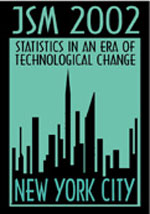|
Activity Number:
|
236
|
|
Type:
|
Invited
|
|
Date/Time:
|
Tuesday, August 13, 2002 : 2:00 PM to 3:50 PM
|
|
Sponsor:
|
Environmental and Ecological Statistics
|
| Abstract - #300139 |
|
Title:
|
Multiscale Raster Map Analysis: Stochastic Models, Statistical Methods, and Computational Tools
|
|
Author(s):
|
Charles Taillie*+ and Ganapati Patil+
|
|
Affiliation(s):
|
Pennsylvania State University and Pennsylvania State University
|
|
Address:
|
421 Thomas Building, University Park, Pennsylvania, 16802, USA 421 Thomas Building, University Park, Pennsylvania, 16802, USA
|
|
Keywords:
|
map characterization and discrimination ; simulation modeling ; patch structure ; fragmentation ; thematic accuracy assessment ; thematic change detection
|
|
Abstract:
|
We discuss three approaches for parametric modeling of categorical raster maps. Fitted parameter values serve as spatial pattern extractors. The disjunctive indicator geostatistical (DIG) model starts with an unobservable numerical response surface defined over the raster grid. Surface values are categorized using a "transitionogram" which, together with the variogram, parameterizes the model.The Hierarchical Markov Transition Matrix (HMTM) model embeds the raster grid at the finest resolution level in a quadtree hierarchy of raster grids.Passage from one level in the hierarchy to the next finer level is accomplished by vertical and horizontal bisection of cells. Stochastic transition matrices govern cell responses at the finer level, conditional on coarser level responses.Markov random fields (MRF) are the final class of models considered. The HMTM can be regarded as a partially observed MRF defined over the full quadtree--this is the key to conditional simulation with the HMTM. The three classes of models are compared with regard to: (i) model fitting (parameter estimation); (ii) absolute and conditional simulation efficiency; and (iii) ability to extract spatial pattern from actual raster maps.
|
- The address information is for the authors that have a + after their name.
- Authors who are presenting talks have a * after their name.
Back to the full JSM 2002 program |

